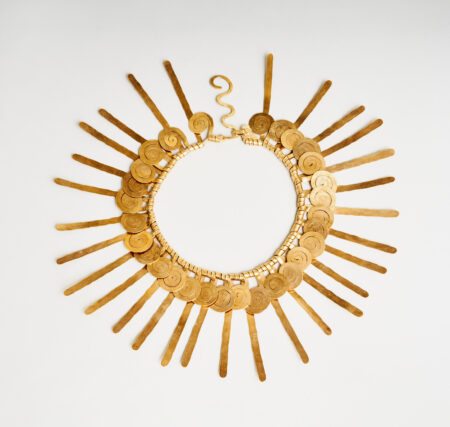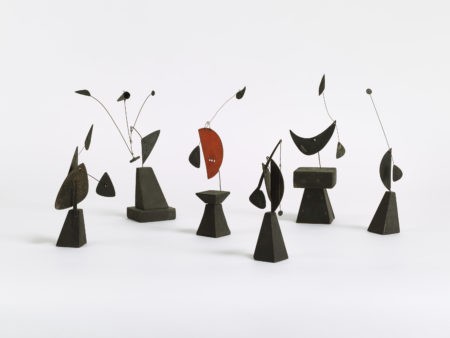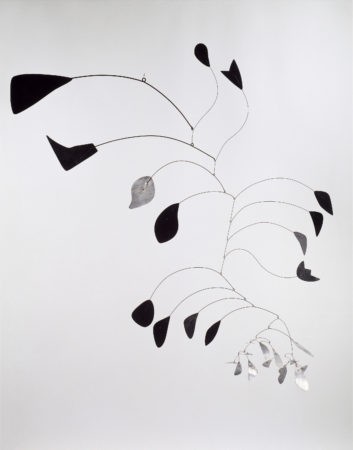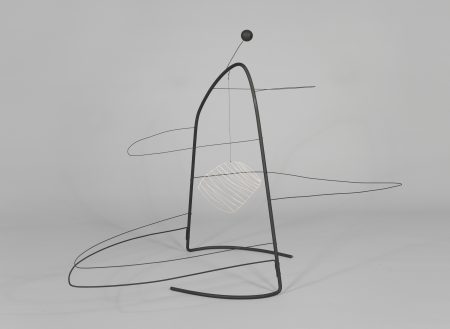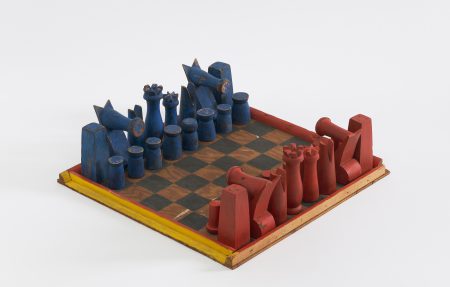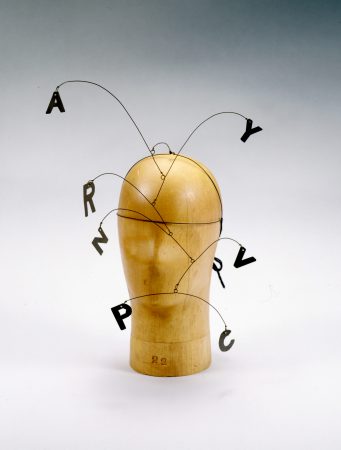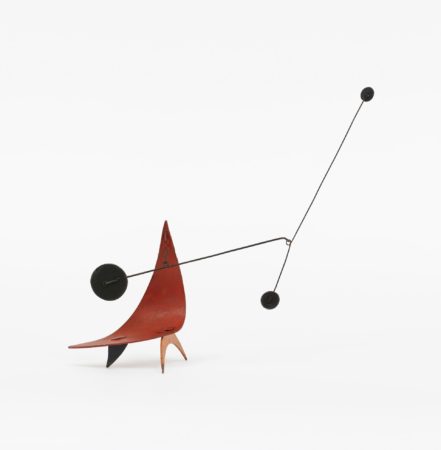Archive
See highlights from 1937–1945 on the timeline Public Commissions and the War
Calder designs scenery and costumes for OO to AH, a playlet in two scenes written by Charles Tracy but never performed.
CF, project file; Tracy 1937Calder’s first large-scale bolted stabiles, Devil Fish and Big Bird, are on view in “Calder: Stabiles & Mobiles” at the Pierre Matisse Gallery, New York.
CF, exhibition file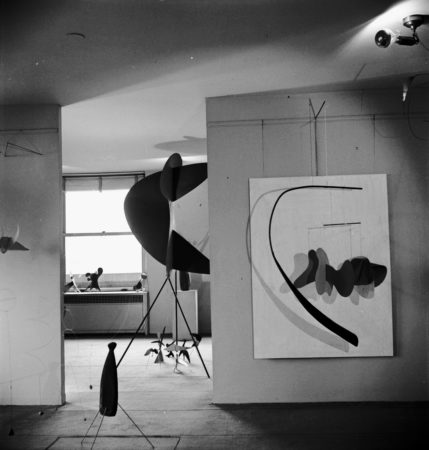
The Calders obtain visas in New York in preparation for their voyage to Europe.
CF, passportThe Calders depart on the SS Lafayette for Le Havre, France. Their daughter Sandra, aged two, and her caretaker Dorothy Sibley join them.
Calder 1966, 156; CF, travel fileThe Calders arrive in Le Havre, France.
CF, passport; Calder 1966, 156Nelson and his wife, Francine, invite the Calders to stay with them in Varengeville, on the Normandy coast. Léger, Pierre Matisse, and Matisse’s wife, Teeny, also visit.
Calder 1966, 156–57The Calders return to Paris, where they move to 80 boulevard Arago, a house designed by Nelson and owned by Calder’s friend Alden Brooks. Visitors include Finnish architect Alvar Aalto and his wife, Aino. Calder uses the garage, outfitted with an automotive turntable, as a studio.
Calder 1966, 157–58Calder and Miró visit the Spanish pavilion under construction at the 1937 World’s Fair site in Paris. Calder meets the pavilion’s architects, Josep Lluís Sert and Luis Lacasa. Sert eventually commissions Calder to make Mercury Fountain for the Spanish pavilion. Mined in Almadén in
Spain, the mercury symbolizes Republican resistance to fascism.
Honolulu Academy of Arts, Hawaii, presents “Fantastic Art: Miró and Calder.”
CF, exhibition fileCalder performs Cirque Calder at 80 boulevard Arago, Paris.
Bruguière Collection, Paris, circus invitationThe Calders rent a house in Varengeville at 50 le Clos du Timbre, where Calder uses the garage as his studio. Jean Hélion, who had been to London a few years before, had put me in contact with John and Myfanwy Piper and Ben Nicholson and Barbara Hepworth, and we lost no
time in inviting the Pipers and the Nicholsons, separately, of course. Other visitors to the house include Georges Braque, Pierre Loeb, Miró, the Nelsons, and cultural theorist Herbert Read.
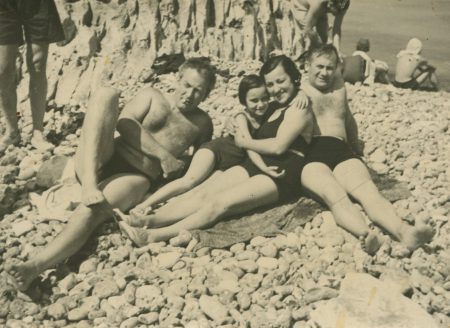
The Spanish pavilion, featuring Picasso’s Guernica, Miró’s Le Faucheur, and Calder’s Mercury Fountain, opens at the Paris World’s Fair.
CF, exhibition file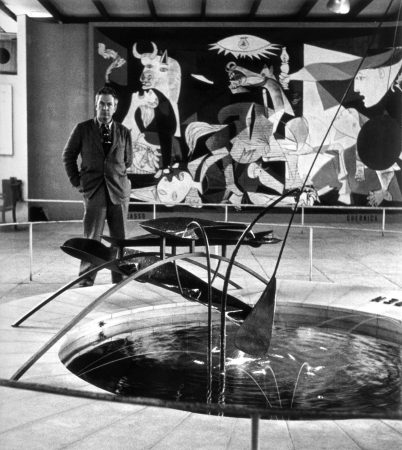
The Calders arrive in Folkstone, England, later renting an apartment at Belsize Park, London. Calder establishes a studio in Camden Town and gives Cirque Calder performances.
CF, passport; Calder 1966, 164–65While in London, Calder makes his first gold necklace for Louisa.
CF, Calder to Warner, 16 December 1946The Mayor Gallery, London, exhibits “Calder: Mobiles and Stabiles.”
CF, exhibition file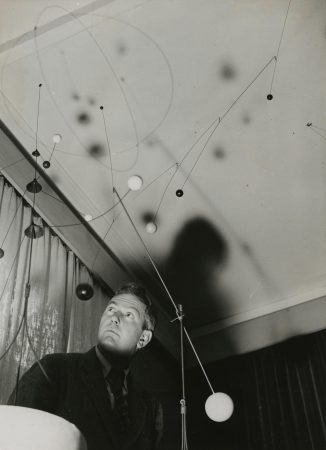
A review of the exhibition at the Mayor Gallery notes, Calder’s jewelry is as pretty as his mobiles—some of it too is “mobile”—and often more seriously lovely. If the lady of fashion has the wit to see it, she may find that pieces of human ingenuity make rather more distinguished ornaments
than Cartier’s portable currency.
In reference to the Mayor Gallery exhibition, Calder writes, The show is going quite well . . . Sold 3 objects so far, + a lot of jewelry. Buyers of his jewelry include prominent characters of London society, including Lady Clark, wife of London’s National Gallery director, Kenneth Clark.
CF, Calder to Sweeney, 14 December; CF, exhibition file, unsigned newspaper clipping from Sketch, 8 DecemberAn unsigned review of the Mayor Gallery in Vogue declares, Calder . . . occasionally makes jewellery of great charm and originality. He bends and twists gold and silver metal into fantastic and gorgeous patterns, very much in the modern manner. Women of taste should ask to see some at the
Gallery.
1938
The Calders return to New York. They rent a different apartment in the building at 244 East Eighty-sixth Street and Second Avenue where they had previously lived.
Calder 1966, 167Calder begins construction of a large studio on the old dairy barn foundations in Roxbury. Soon after, he converts his icehouse studio into a living space that comes to be known as the “Big Room.”
Calder 1966, 169–70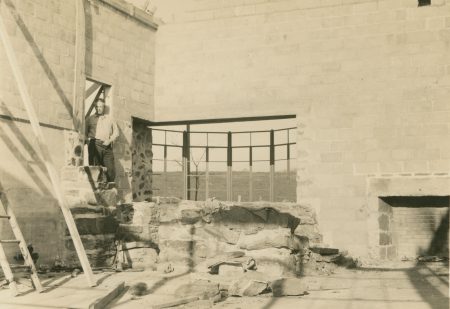
Calder’s first retrospective, “Calder Mobiles,” is presented by the George Walter Vincent Smith Gallery, Springfield, Massachusetts. Sweeney writes a foreword to the catalogue. Aalto, Léger, architectural historian Siegfried Giedion, and art patron Katherine S. Dreier attend the
opening. Sixty-one pieces of jewelry are included in the exhibition.
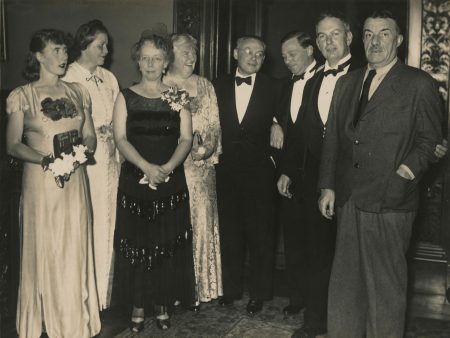
Artek Gallery, Helsinki, presents “Alexander Calder: Jewelry.”
CF, exhibition file1939
Calder is commissioned by the Museum of Modern Art, New York, to make Lobster Trap and Fish Tail, a mobile he installs in the principal stairwell of the museum’s new building on West Fifty-third Street.
Lipman 1976, 332; Marter 1991, 197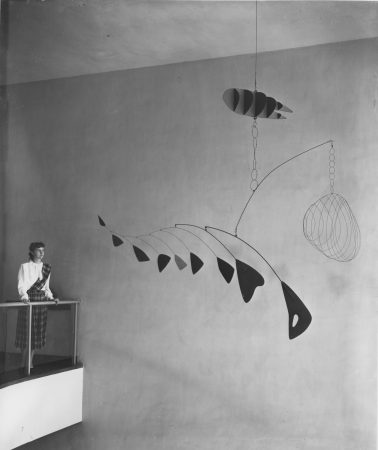
Calder is invited to make sculptures for an African habitat designed by Oscar Nitzschke for the Bronx Zoo. Calder conceives of treelike sculptures to be made in steel so they can withstand the abuse of the wild animals. Although the habitat is never realized, Calder creates five
models for the project: Sphere Pierced by Cylinders, Hollow Egg, Four Leaves and Three Petals, Leaves and Tripod, and The Hairpins.
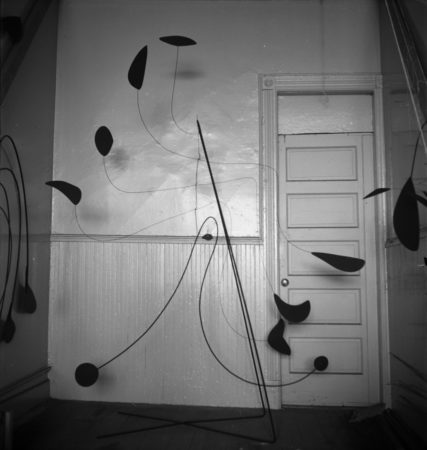
Calder creates six maquettes to complement architect Percival Goodman’s design for the Smithsonian Gallery of Art Architectural Competition, sponsored by the Smithsonian Gallery of Art Commission. Goodman is awarded second place to Eliel Saarinen, and the
project goes unrealized.
The exhibition “III Salão de Maio,” São Paulo, Brazil, includes gouaches and a mobile by Calder.
CF, exhibition fileCalder is commissioned by Wallace K. Harrison and André Fouilhoux, architects of Consolidated Edison’s pavilion at the 1939 New York World’s Fair, to design a “water ballet” for the building’s fountain. Although water jets are installed around the pavilion, this ballet is never
executed.
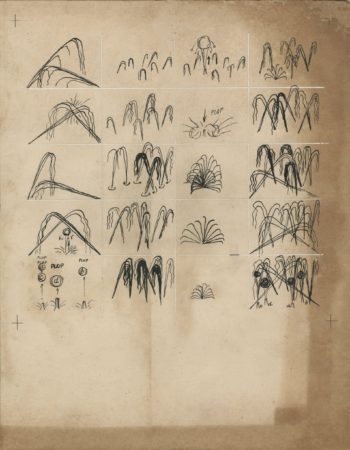
Calder submits a Plexiglas stabile to a competition sponsored by Röhm and Haas at the Museum of Modern Art, New York. The work is exhibited at the Hall of Industrial Science during the New York World’s Fair.
CF, exhibition file; Calder 1966, 175; "Abstract Sculpture in Plexiglas," 1939“Calder Mobiles–Stabiles” is on view at the Pierre Matisse Gallery, New York.
CF, exhibition file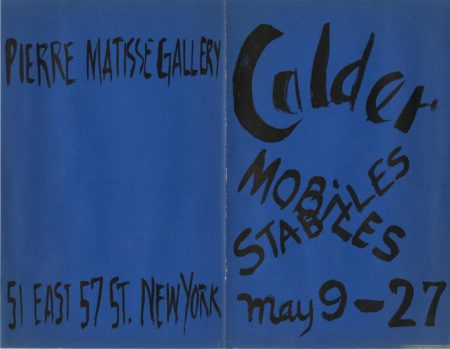
The Calders’ second daughter, Mary, is born.
Calder 1966, 174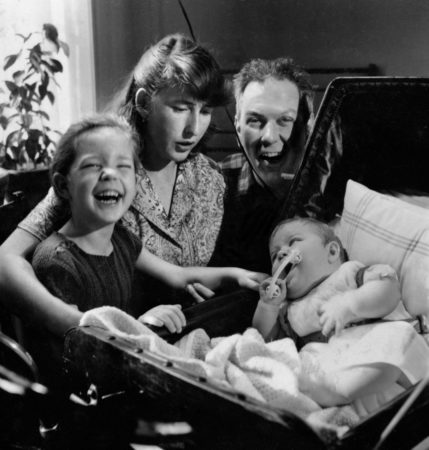
Sert and his wife, Moncha, pay an extended visit to the Calders in Roxbury.
Calder 1966, 1741940
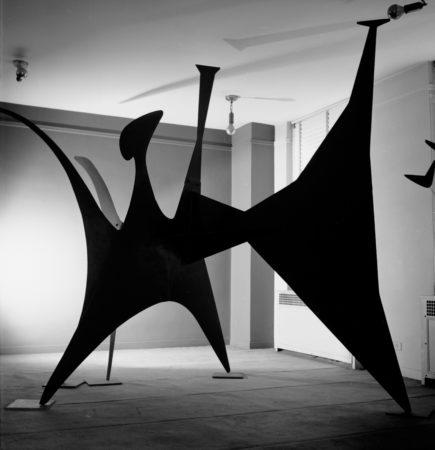
Marian Willard shows an array of Calder’s jewelry to Valentina, a renowned haute couture dressmaker in New York. Valentina objects to the prices of the items and Willard takes them next to Harper’s Bazaar where they are photographed.
CF, Willard to Calder, 9 OctoberA private exhibition of Calder’s sculptures takes place inside and outside the home of Wallace Harrison and his wife, Ellen, in Huntington, Long Island.
MoMA, invitation; CF, Myra Martin to Ellen Harrison, 24 OctoberCarmel Snow, the legendary editor of Harper’s Bazaar, writes to Willard: The photographs of Sandy Calder’s jewelry turned out beautifully . . . we will publish these either in December or January.
CF, Snow to Willard, 16 October“Calder Jewelry” is presented at Willard Gallery, New York. In her press release for the show, Willard writes, These works of art are savage and deliberate and self-confidently sophisticated . . . This is a master modern artist’s contribution to the history of fashion. For a world already in
chains it is superb stuff.
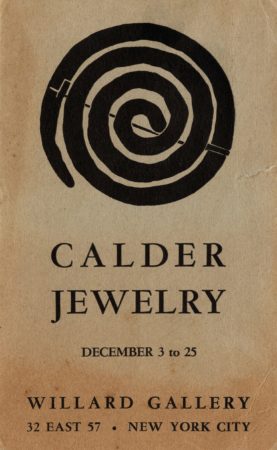
1941
Harrison commissions Calder to make a mobile for the Hotel Avila Ballroom, Caracas, Venezuela.
CF, project file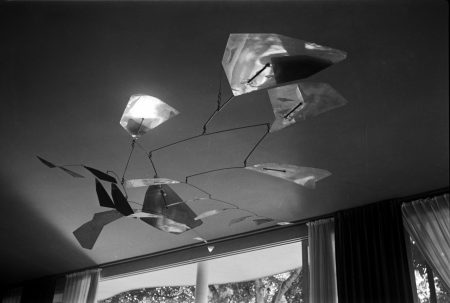
“Alexander Calder: Mobiles / Jewelry” and “Fernand Léger: Gouaches / Drawings” are presented at the Arts and Crafts Club of New Orleans. Twenty-five works of jewelry are exhibited.
CF, exhibition fileHerbert Matter photographs Calder’s Roxbury studio.
CF, photography file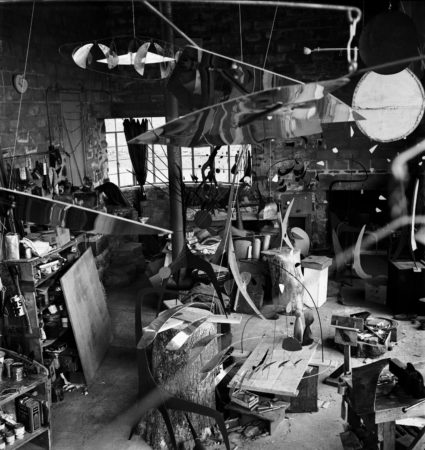
“Alexander Calder: Recent Works” is held at the Pierre Matisse Gallery, New York.
CF, exhibition file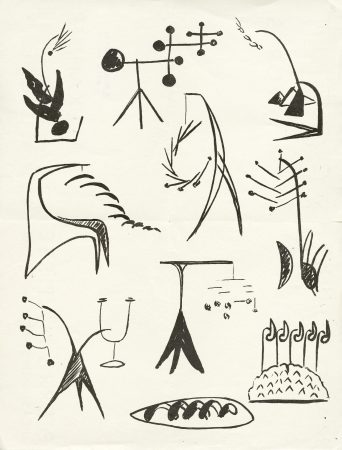
Calder performs Cirque Calder in Roxbury.
CF, object file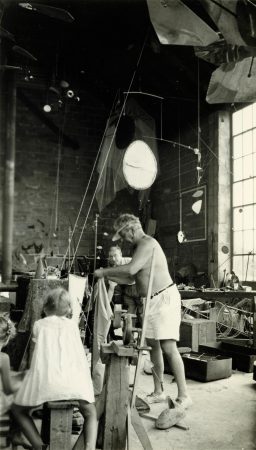
“Calder: Mobiles, Stabiles, Jewelry” and “A Few Paintings by Paul Klee” are on view at the Design Project, Los Angeles. Sent along with the jewelry is an inventory book with illustrations by Calder of each piece.
CF, exhibition fileFollowing the success of the previous year, Willard planned a second jewelry show. As she wrote to Calder, I am a little concerned about the lack of “jewels” on the horizon at present . . . You will have to do prodigious work the next two months. Remember the small, well
fashioned, wearable ones are what we will cash in on.
Calder sends jewelry to Charlotte Whitney Allen in Rochester, who plans to display it for the Christmas season. The jewelry is here and it is too beautiful. I hope we will sell a lot and make our everlasting fortune. We can’t find any list of pieces. Was there one in the box or will you send it later.
CF, Allen to Calder, 4 NovemberTanguy and Kay Sage, the Surrealist painters, rent a home from their friend Hugh Chisholm in nearby Woodbury, Connecticut, and become close friends of the Calders. Rose and André Masson live in nearby New Preston.
Suther 1997, 106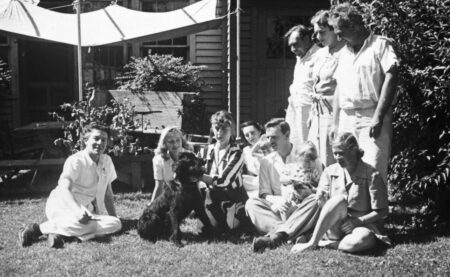
Ellen Harrison asks Calder if he is interested in exhibiting his jewelry in Washington, D.C.: Everyone is in Washington these days and there is nothing to by [sic]. I wonder if you would like to show your jewelry if a decent place for such an exhibit could be found? . . . I will ask around if you
would like to have me do so.
Elizabeth Rockwell, owner of the Outlines Gallery in Pittsburgh, writes to Calder: Starting on November 16 there is an exhibit of modern prints, woodcuts, etchings, lithographs, etc.—and I am wondering whether I might show some of your jewelry concurrently with this exhibit.
CF, Rockwell to Calder, 3 November“Mobiles by Alexander Calder, Stabiles and Jewelry” is held at the San Francisco Museum of Art. Eighty pieces of jewelry are exhibited: The “jewels” fashioned from odd pieces of metal and rocks are an adventure.
CF, exhibition file; San Francisco Chronicle, 16 NovemberAt her request, Calder sends Charlotte Whitney Allen an inventory book of the jewelry he has sent her. It is an illustrated list of each work sent drawn in a composition notebook. She thanks him in a letter for the “most explicit list” and writes that the window display of his jewelry
that she has arranged “is really quite grand and everyone is very enthusiastic.”
Calder sends thirty-five works of jewelry to Rockwell of the Outlines Gallery for inclusion in a group exhibition. An illustrated list of works accompanies the shipment.
CF, illustrated jewelry list dated by CalderWillard Gallery, New York, exhibits “Calder Jewelry.” After setting up the exhibition the previous day, Calder returns briefly to Roxbury on the morning of 8 December to pick up Louisa and bring her to New York for the show’s vernissage. Upon his arrival, Louisa informs him that the
Japanese had attacked Pearl Harbor the previous day and the United States has entered World War II.
Calder sends thirty-four works of jewelry that have recently been returned to him from his exhibitions in California to Ellen Harrison in Washington, D.C.
CF, jewelry inventory book1942
Calder meets artist Saul Steinberg.
CF, Whitney memorial programCalder is commissioned to make Red Petals for the Arts Club of Chicago.
Calder 1966, 185–86; CF, Rue Shaw to Calder, 3 March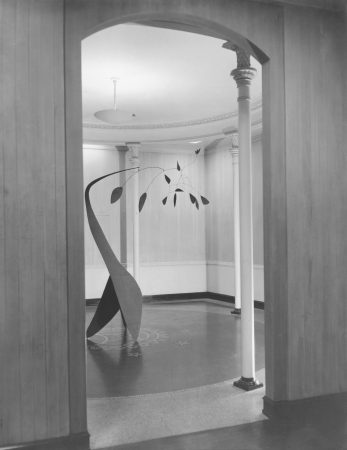
Sculptures by Calder and paintings by Miró are exhibited at Vassar College, Poughkeepsie, New York.
CF, exhibition file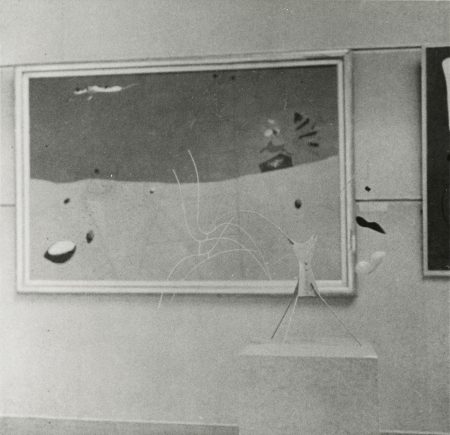
After several months with his jewelry, Rockwell of Outlines Gallery writes, Tomorrow the jewelry will be packed and sent. I would like to keep it even longer but unfortunately there seems no hope of selling more . . . I am sorry to hear that your recent exhibits have not been very successful
and I wish that I had more success with mine. The war, I suppose.
In regard to the jewelry sent from Calder the previous winter, Ellen Harrison writes, I hated to send you back your . . . things without removing even one piece last winter. Well let’s forget that one.
CF, Ellen Harrison to Calder“Calder: Recent Work” is held at the Pierre Matisse Gallery, New York.
CF, exhibition fileCalder performs Cirque Calder at Herbert and Mercedes Matter’s apartment, 328 East Forty-second Street, New York.
CF, Calder to de Creeft, 18 MayThe first issue of VVV, a Surrealist journal founded and edited by David Hare in collaboration with editorial advisers Breton and Max Ernst, is published. The issue features two Matter photographs of Calder’s Roxbury property. Written below the photographs:
In our days the aviary of all
Light and the nocturnal refuge
Of all tinkling.
The Studio of Alexander Calder, Roxbury, Conn.
The time of enchantment and the art of living.
Calder is classified 1-A (top eligibility) by the army, though he is never drafted. He studies industrial camouflage at New York University and applies for a commission in camouflage work with the Marine Corps: Although the army says that the painter is of little or no use in modern
camouflage, I feel that this is not so, and that the camoufleur is still a painter, but on an immense scale . . . and in a negative sense (for instead of creating, he demolishes a picture and reduces it to nil . . . ).
The Coordinating Council of French Relief Societies sponsors the exhibition “First Papers of Surrealism” at the Whitelaw Reid Mansion, New York, organized by Breton and Duchamp. Duchamp creates his mile of string on which he invites Calder to hang his works. Calder proceeds to
construct small paper sculptures intended as a pun on the exhibition’s title. However, Breton vetoes the collaboration, and the large standing mobile The Spider is installed.
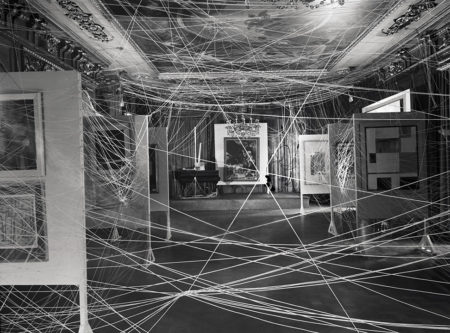
The inaugural exhibition of Peggy Guggenheim’s Art of This Century, New York, opens with an installation designed by Frederick Kiesler. Guggenheim wears one earring by Tanguy and one earring by Calder, who is represented in the exhibition by Arc of Petals.
Lader 1981, 363–67The Calders move to 255 East Seventy-second Street. After housing Luis Buñuel and his family at 244 East Eighty-sixth Street, the Calders eventually signed over the lease to them.
CF, Masson to Calder, 12 November“Artists for Victory: An Exhibition of Contemporary American Art” is presented at the Metropolitan Museum of Art, New York; Calder wins fourth prize. Other prizewinners include de Creeft and Philip Evergood who are interviewed with Calder at the museum for a WABC Radio
program, Living Art, that broadcasts on 8 December.
Calder works on a new open form of sculpture made of carved wood and wire. They had a suggestion of some kind of cosmic nuclear gases—which I won’t try to explain. I was interested in the extremely delicate, open composition. Sweeney and Duchamp propose the name “constellations” for
these works, seven of which will be included in the artist’s upcoming retrospective at the Museum of Modern Art, New York.
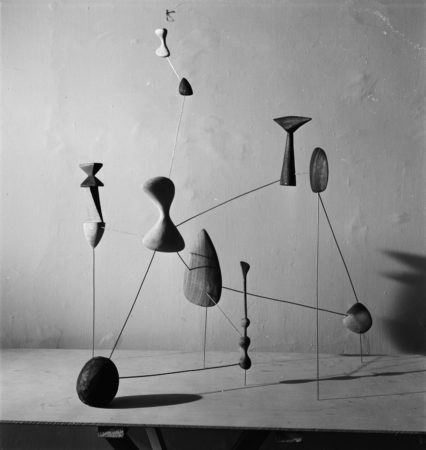
1943
Art of This Century, New York, hosts “Exhibition of Collage,” including works by Arp, Braque, Calder, Joseph Cornell, Duchamp, Ernst, Robert Motherwell, and Picasso.
Lader 1981, 375“Calder: Constellationes” is shown at the Pierre Matisse Gallery, New York.
CF, exhibition file“17 Mobiles by Alexander Calder” is held at the Addison Gallery of American Art, Andover, Massachusetts. The catalogue contains a statement by Calder: At first [my] objects were static, seeking to give a sense of cosmic relationship. Then . . . I introduced flexibility, so that the relationships
would be more general. From that I went to the use of motion for its contrapuntal value, as in good choreography.
Calder writes to Sweeney about his forthcoming retrospective at the Museum of Modern Art, New York. I forgot to show you this object. One swings the red (iron) ball in a small circle—this movement and the inertia of the rod and the length of thread develops a very complicated
pattern of movement. The impedimenta—boxes, cymbal, bottles, cans etc. add to the complication, and also add sounds of thuds, crashes, etc.—This is a reconstruction of one I had in Paris in ’33. I will bring it down and set it up for you to see. I call it the “Small Sphere and Heavy Sphere.”
Arnold Newman photographs Calder at the Museum of Modern Art, New York.
CF, photography file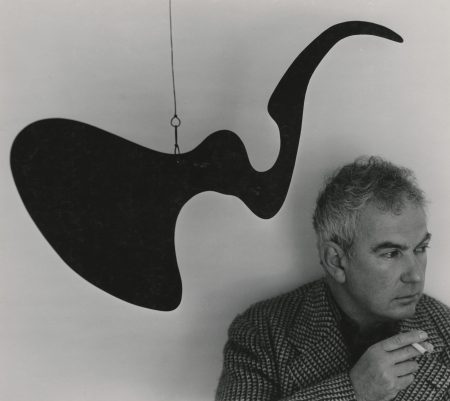
The Museum of Modern Art, New York, presents “Alexander Calder: Sculptures and Constructions,” curated by Sweeney and Duchamp. Calder writes, Simplicity of equipment and an adventurous spirit in attacking the unfamiliar or unknown are apt to result in a primitive and
vigorous art. Somehow the primitive is usually much stronger than art in which technique and flourish abound. Originally scheduled to close on 28 November 1943, the exhibition is extended to 16 January 1944 due to public demand.
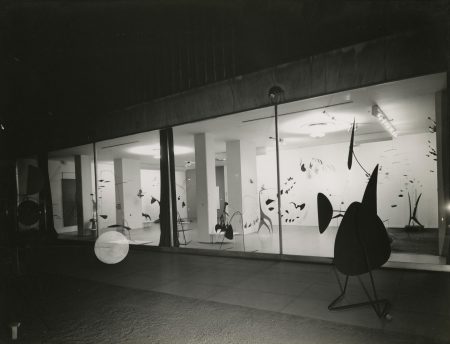
Calder performs Cirque Calder at the Sweeneys’ apartment at 120 East End Avenue in New York.
CF, Louisa memorial fileCalder gives two performances of Cirque Calder in the Members Room of the Museum of Modern Art, New York, for friends and staff.
CF, exhibition filePeggy Guggenheim presents “Natural, Insane, Surrealist Art” at Art of This Century, New York. Organized with Ladislas Segy, the exhibition features two works by Calder, as well as works by Ernst, Klee, Masson, Roberto Matta, Miró, and Tanguy, among others.
Lader 1981, 385Calder travels to Chicago to prepare for his exhibition of jewelry at the Arts Club.
CF, exhibition file; NL, Calder to Shaw, 13 November; Calder 1966, 185The Arts Club of Chicago exhibits “Jewelry by Alexander Calder.”
CF, exhibition file; NL, Calder to Shaw, 13 November; Calder 1966, 185Both the “Big Room” and part of the Roxbury farmhouse are destroyed by an electrical fire. Louisa tells Calder about the fire when he joins them on 7 December. What was destroyed was the icehouse, my original workshop, where the electricity had probably shorted, and the
woodshed and a corner of the bathroom. The toilet, which was of china, had exploded. It must have been a dreary business for Louisa and Malcolm to drag all they could save to my new shop—this seemed to fill it completely when I got there. Gone were the unencumbered spaces.
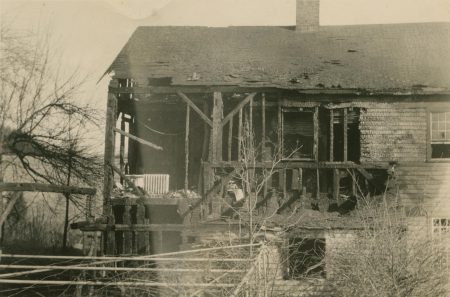
1944
Agnes Rindge Claflin writes and narrates Alexander Calder: Sculpture and Constructions, a film based on the retrospective at the Museum of Modern Art, New York. Cinematography is by Matter.
CF, project fileCalder gives Black Flower to the Museum of Western Art in Moscow.
Calder 1966, 185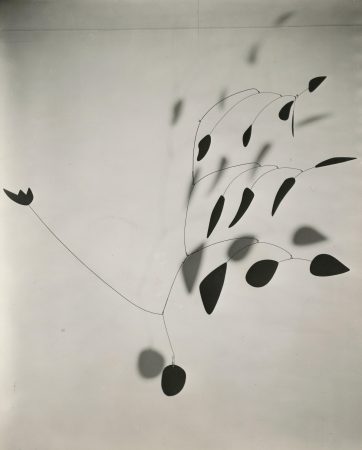
Calder visits Mondrian in the hospital shortly after he lapses into a coma. Calder is among those present—with Richter, Dudensing, Sweeney, and others—when Mondrian dies at 5:08 a.m.
CF, Holtzman diary, 1 FebruaryCalder attends Mondrian’s memorial service at the Universal Chapel at Lexington Avenue and Fifty-second Street, New York.
Bois 1994, 85“Color and Space in Modern Art Since 1900” is on view at Mortimer Brandt, New York. The exhibition includes three sculptures by Calder, including Cage within a Cage and Morning Star.
MA, brochureCalder’s Black Flower is loaned by the Russian Embassy in Washington, D.C., to “Calder: Paintings, Mobiles, Stabiles and Jewelry,” held at the local gallery France Forever. Calder attends the preview on 26 March, organized under the patronage of Henri Hoppenot, Minister
Plenipotentiary, Delegate of the French Committee of National Liberation, and he performs Cirque Calder on 25 and 26 March at the Dance Playhouse, through the courtesy of Evelyn Davis.
Calder makes the acquaintance of Keith Warner, owner of a leather manufacturing company and already a patron of several artists. He also becomes a devoted supporter of Calder. Until his death in 1959, Warner commissions dozens of works by Calder, including at least ten
works of jewelry for his wife, Edna. Among these are some substantial pieces fashioned from gold.
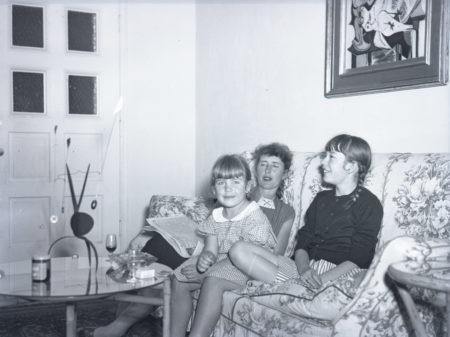
In New York, Calder meets Brazilian architect Henrique Mindlin.
Calder 1966, 198The Calders live in the Tanguy-Sage household in Woodbury, Connecticut, while the burned home is repaired. Nitzschke made some very nice plans for the rebuilding + enlargement of the shop, but we are still awaiting …. In the kitchen [the] partition between it + the dining room has
been removed, and we have steel French windows (6′ wide) and a door leading outside.
Curt Valentin publishes Three Young Rats and Other Rhymes, with eighty-five drawings by Calder and edited by Sweeney.
CF, project fileCalder is represented by a work on paper in the exhibition “Abstract and Surrealist Art in the United States” at the San Francisco Museum of Art.
CF, exhibition fileThe exhibition “Recent Work by Alexander Calder” at Buchholz Gallery/Curt Valentin, New York, includes recent plaster and bronze sculptures and the drawings for Three Young Rats and Other Rhymes.
CF, exhibition file“The Imagery of Chess: A Group Exhibition of Paintings, Sculpture, Newly Designed Chessmen, Music, and Miscellany” is presented at Julien Levy Gallery, New York. Calder exhibits two chess sets alongside works by Duchamp, Ernst, and Tanguy, among others.
CF, exhibition fileAfter complaining to Calder that she has nothing to wear to the upcoming Vassar College Christmas party, Claflin receives a tiara that Calder dubs Fire Proof Veil. The headpiece is constructed of a series of sheet metal letters, “A, R, V, C, P, N, Y,” each dangling from its own wire
attached to a central headband. The letters stand for “Agnes Rindge Vassar College Poughkeepsie New York” and are designed to hang in front of the wearer’s face.
1945
Calder’s father, Alexander Stirling Calder, dies in Brooklyn. Calder and Louisa leave their daughters in the care of the Massons and bury Stirling in Philadelphia.
ASCR conversation with Mary Calder Rower, 16 November 1997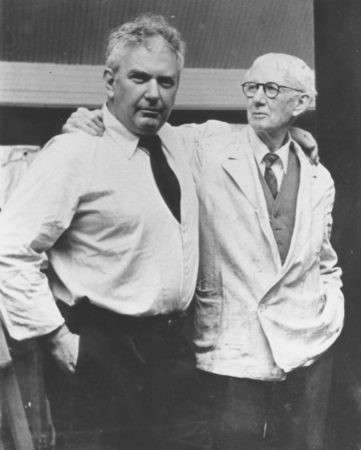
Buchholz Gallery/Curt Valentin, New York, presents “Recent Work by American Sculptors” and includes a standing mobile by Calder.
AAA, catalogueCalder receives a contract from composer Remi Gassmann on behalf of the University of Chicago for the design of costumes and scenery for the dance project Billy Sunday.
CF, Gassmann to Calder, 14 March; CF, Calder to Warner, 6 March, 2 AprilMasson brings French author and philosopher Jean-Paul Sartre to visit Calder in Roxbury.
CF, Calder to Zervos, 25 May; Calder 1966, 188–89Commissioned by the Museum of Modern Art, New York, to make a work for the sculpture garden, Calder creates Man-Eater with Pennants.
CF, Calder to Warner, 1 June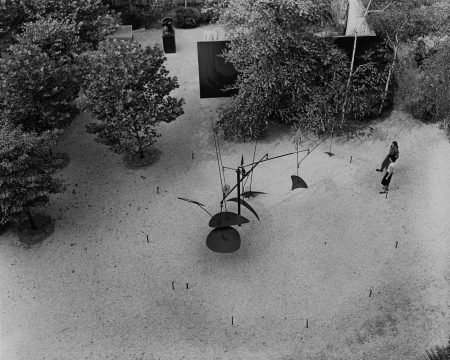
The Museum of Modern Art, New York, presents the First Exhibition of the Museum Collection of Painting and Sculpture. Calder is represented by five sculptures.
CF, exhibition fileCalder produces a series of small-scale works, many from scraps trimmed during the making of other objects. Let’s mail these little objects to [Louis] Carré, in Paris, and have a show, Duchamp suggests when he sees them; by taking advantage of the newly available international
airmail system, Duchamp’s action predates “mail art” by nearly two decades. Carré responds to Duchamp’s proposal. Interested show Calder miniatures would also gladly exhibit mobile sculptures available all sizes and colours.
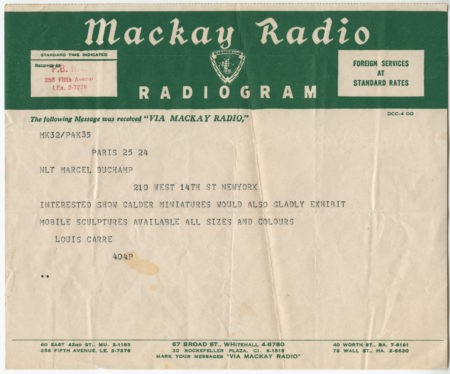
Calder packs thirty-seven miniature mobiles and stabiles into six small cartons and mails them to Carré in Paris. Due to U.S. Postal Service regulations, he gives the name of six different senders for each package: himself, Duchamp, Masson, Sweeney, Tanguy, and Renée
(Ritou) Nitzschke.
